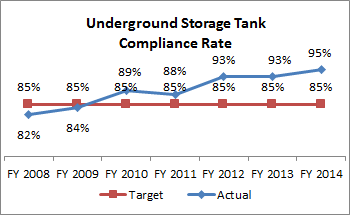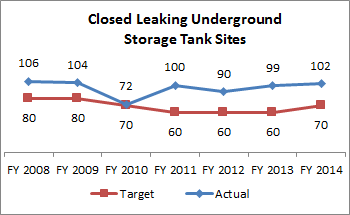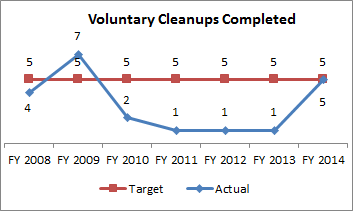The mission of the Division of Environmental Response and Remediation (DERR) is to protect the health and the environment of the citizens of Utah from exposure to hazardous substances. DERR administers three major federal environmental laws.
During the 2015 General Session, the Legislature appropriated for Fiscal Year 2016, $7,583,800 from all sources for Environmental Response and Remediation. This is a 12.6 percent increase from Fiscal Year 2015 revised estimated amounts from all sources. The total includes $780,600 from the General/Education Funds, an increase of 2.7 percent from revised Fiscal Year 2015 estimates.
In addition to statewide compensation and internal service fund cost increases, the following appropriation adjustments were made during the 2015 General Session:
Underground Storage Tank Compliance
This measure evaluates underground storage tank (UST) facility compliance with key regulatory provisions that likely prevent or minimize human environmental impacts from UST releases (petroleum). Metrics for "significant operational compliance" fall into two categories: release prevention and release detection. The primary mechanism for successful results is outreach and education of facility owners/operators. Verification is done by inspections and compliance is by follow-up and enforcement. The graph below shows the percentage of UST facilities that meet the requirements for release prevention and release detection within 60 days of the compliance inspection done by the division.

Closed Leaking Underground Storage Tank Sites
Closing leaking underground storage tank (LUST) sites is an important performance measure to the state and EPA. "Closing" a LUST site means the site has been cleaned up to standards protective of human health and the environment. Cleanup to closure also facilitates redevelopment. On a national level, Utah ranks in the top 10% of states that have closed out most of their LUST sites. Utah has had 5,110 LUST release sites and has closed 4,704 of them.

Voluntary Cleanups Completed

This measure benchmarks productivity of moving sites through the voluntary cleanup program (VCP) to completion. Evaluating completion numbers on an annual basis allows the division to benchmark sites against a period of time (one year). There are many factors that weigh in on the time to completion, such as size and complexity of the site and associated contamination, timeframe of the applicant, economic conditions, etc. The downward trend reflects the challenging economic climate. VCP participation is 100% voluntary; the speed of cleanup slows when applicant money is less.
Other Environmental Response Performance Measures
In addition to the key performance measures listed above, the division reported the following performances measures for FY 2014:
- inspected 971 underground storage tank facilities for compliance;
- closed 55 petroleum storage tank (PST) fund covered releases and 47 non-PST leaking underground storage tank (LUST) releases for a total of 4,704 cumulative releases closed to date;
- received and coordinated 315 incident notifications; and,
- issued five Certificates of Completion (COC) for Voluntary Cleanup Program sites for a total of 46 COC and No Further Action decisions in the program to date.
The Division of Environmental Response and Remediation protects public health and the environment through the following means:
- coordinating notifications and responses to incidents posing imminent hazards;
- implementing corrective actions (clean-up);
- providing educational services to the public;
- ensuring compliance with regulations; and
- managing risks and hazards.
The major functions of the division include the following:
- conduct site investigations;
- negotiate and coordinate clean-up activities;
- encourage voluntary cleanup of contaminated sites;
- perform risk assessments;
- coordinate enforcement activities;
- provide compliance activities;
- conduct certification training;
- establish design and operation standards;
- coordinate emergency response and planning;
- coordinate division safety program;
- collect and analyze chemical inventory and usage data;
- coordinate cost recovery actions;
- release prevention inspections and education; and,
- provide the public with chemical inventory of usage data.
DERR was created from the Bureau of Solid and Hazardous Waste (BSHW) on July 1, 1990 to more effectively administer the rapidly expanding role of three federal environmental laws: The Comprehensive Environmental Response Compensation and Liability Act, the Emergency Planning and Community Right-to-Know Act (EPCRA), and the Resource Conservation and Recovery Act (RCRA), Subtitle I, Regulation of Underground Storage Tanks.
The division is organized into two major branches, the Comprehensive Environmental Response Compensation and Liability Act (CERCLA) Branch (commonly known as Superfund) and the Underground Storage Tank Branch.
Through cooperative agreements with the U.S. Environmental Protection Agency (EPA) or Federal Facility Agreements with federal agencies, the division is involved in all hazardous waste sites in Utah that are included or are being investigated for the National Priorities List (NPL). The NPL is established by the federal, non-delegated CERCLA program. Utah has over 500 sites on the active or archived CERCLA list. Of these, 25 sites have been proposed with 21 of these finalized and on the NPL at the end of FY2014. Cleanup has been completed at 14 NPL sites.
The division administers the Voluntary Cleanup Release program since it was enacted by the Utah Legislature in 1997. This program allows for cleanup of contaminated properties not otherwise addressed by other regulatory program by owners, purchasers, or others voluntarily with state oversight.
The division administers the Underground Storage Tank (UST) program which is charged with enforcing state and federal underground storage tank regulations in Utah. The UST section conducts inspections at underground storage tank facilities to ensure compliance with leak prevention and leak detection requirements. The UST section administers various certification programs for underground storage tank installers and removers, inspectors, precision tank testers, groundwater, soil samplers, consultants, and registration of UST operators. Additionally, the section reviews and approves plans for closure of tanks, helps owners receive coverage under the State's Petroleum Storage Tank (PST) Trust Fund, presents public information outreaches, and pursues tank compliance actions. The UST program has established standards for the design, installation, closure, operation and monitoring of regulated underground storage tanks. Local health departments are utilized to assist in conducting inspections and providing complaint response at a local level.
The Leaking Underground Storage Tank Remedial Assistance section has the responsibility for overseeing clean-up activities at leaking underground storage tank sites. This section monitors compliance with schedules and public information, approves corrective action technology, and directs site investigations and remediation work conducted by state Level of Effort (LOE) contractors. Additionally, this section ensures that cleanups occur at sites where the responsible party (RP) is unwilling, unable, or unknown by taking necessary compliance actions against RPs, utilizing state cleanup funds for high priority sites when the RP does not act, and initiating cost recovery as appropriate. This section also responds to tank emergencies.
The PST Remediation section is responsible for administering the Petroleum Storage Tank Fund, which is a state trust fund established to provide financial assurance for underground storage tank owners to clean up releases from their tanks. Claims against the fund are processed, clean-up work reviewed and approved, and assistance given to underground storage tank owners to complete the clean-up process. An independent accounting firm conducts an actuarial analysis of the PST Fund annually. The actuarial report for FY 2014 projects a positive cash balance for the next 10 years. HB138 mandated the transfer of assets of the PST Loan Fund ($5.9 million) into the PST Trust Fund at the end of FY2014. This transfer increased the cash balance of the PST Trust Fund to $17.6 million. The 2014 actuarial report projects that the cash balance of the fund will increase to $22.2 million by 2024.
Final authorization from the EPA to administer the federal rules for the Underground Storage Tank program in Utah has been received.
COBI contains unaudited data as presented to the Legislature by state agencies at the time of publication. For audited financial data see the State of Utah's Comprehensive Annual Financial Reports.